Museums and Exhibitions in New York City and Vicinity
| Home | | Museum Guide | | International | | Architecture & Design | | Theater |
GLENN LONEY'S MUSEUM NOTES
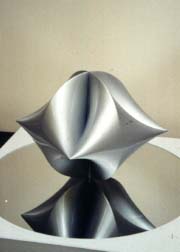
| |
| SCULPTURE & TIME-CAPSULE--Santiago Calatrava's winning design for Millennial repository at American Museum. | |
[01] New York Times Time-Capsule
[02] Feathered Dinosaur from China
[03] Did God Create Fossils?
[04] PARKETT: Artist-Magazine Collaborations
[05] Digital Art at the Whitney
[06] Classical Images at Dahesh
[07] Joel Shapiro on Met Roof
[08] Jacqueline Kennedy: The White House Years
[09] Visionary William Blake at the Met
[10] Rare Books at Park Avenue Armory
For editorial and commercial uses of the Glenn Loney INFOTOGRAPHY/ArtsArchive of international photo-images, contact THE EVERETT COLLECTION, 104 West 27th Street, NYC 10010. Phone: 212-255-8610/FAX: 212-255-8612.
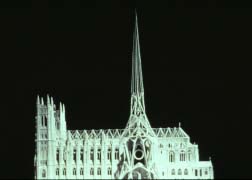
| |
| POST-MODERNIST SPIRE FOR ST. JOHN THE DIVINE--Major element of Calatrava's design for completion of Morningside Heights Cathedral. | |
As you can see in print, all these honorifics can become cumbersome. Dr. Futter, in fact, almost gave a sputter, as she tried to articulate Boorstin's new title. She chuckled, inviting the assembled guests to try saying "Times' Time-Capsule Keeper" several times "very fast."
The venerable Dr. Boorstin was genial with the press, but, advanced in age, he seems in no condition to defend the Time-Capsule against assorted New York Muggers, Vandals, Goths, or Anti-Establishment-Art Protesters.
Some of whom may well resent the selection of the Time-Capsule design of Spain's brilliant architect/engineer/sculptor Santiago Calatrava—an All-Purpose Renaissance Man.
Instead of burying this new repository of Artifacts of This Age—as has been the custom in Preservations Past—Calatrava's Container stands proudly above ground in Theodore Roosevelt Park on a black granite base. It is in fact a magnificent shining sculpture which conceals its treasures in four segments.
This hollow sculpture was developed from a series which explored the varied properties of folded spherical frames. [If you have the right software, you could try this for yourself!]
Calatrava suggests that the metal sculpture/container resembles a flower. Some commentators have made comparisons which are less botanical, more biological.
Staring at it while waiting for the Great & Famous to assemble, I thought it could suggest a Formalist Formation of a Famous Human Crevice. Rather like a geometric abstraction of those floral-forms Georgia O'Keeffe was so fond of fondling with her brush…
Parks Commissioner Henry Stern, at the podium, also stared long & hard at the Time-Capsule. Then—in the absence of New York's Moral-Crusade Mayor—he solemnly said: "I declare this Art decent!" That won a chuckle from many.
The contents of the Capsule—chosen from thousands of suggestions—have been selected to represent Life at the End of the 20th Century.
The optimistic expectation of the American Museum, of Ellen Futter, of the New York Times, and, indeed, anyone involved in promoting this project, is that it will be opened a Thousand Years From Now, in 3001, when Humanity may well be grappling with the problems of Y3K.
Of course, there's always the possibility that Manhattan will be under a thousand feet of water by then. Or that it will have been blasted off the face of the planet. Or that the planet itself will have been destroyed, making the Opening of the Capsule moot.
A distinct advantage of positioning a Time-Capsule above ground—and making it in form an Artwork—is that it won't so easily be overlooked or forgotten. Are there any unopened Time-Capsule's around of which we have totally lost track?
When the 1939 World's Fair opened in Flushing Meadows Park, they prepared a Time-Capsule as well. The intent, as with the new installment, was to give Generations Yet Unborn a cultural/political/social cross-section of the Age of Art Deco.
And of the New Deal, of course. Among the trivia entombed was one of Hedda Hopper's hats and a copy of Eleanor Roosevelt's syndicated newspaper column, "My Day."
Who now remembers Hedda Hopper? Or her hats? Was she any relation to Dennis Hopper? [Who is he?]
In case you are too impatient to wait for 3001—to see what is inside—here are some of the artifacts preserved in the New York Times' Time-Capsule:
Group I: [Items from Fountain, Colorado, designated by the New York Times as "the archetypal suburban American Town." Significantly, the Times did not pick Columbine, Colorado!]
Purple Heart, Unicorn Beanie Baby, Food Stamp ID Card, Motorola Cellular Phone, Dog-tags, Barbed Wire, WalMart Bar Codes, etc.
Group II: [Representing Small Towns around the world.]
Condoms from Zimbabwe, Vial of Penicillin from France, Parking-Ticket from Brazil, etc.
Group III: [Selected by NY Times Magazine editors, presumably including Jack Rosenthal—whose idea & initiative the capsule was.]
Acid-free copies of NYTM Millennium Issues, LP of Late 20th Century Sounds, St. John's Wort capsule, Mac Mouse, Letterman Top-Ten List, NY Yankee baseball, hair from cloned-sheep Dolly, Butt Blaster manual, Weight-Watchers Magazine, Holy Bible, National Enquirer, Peyton Place, I Capture the Castle, Bridges of Madison County, Survival in Auschwitz, Betty Crocker Cookbook, and—among many other items of trivia—a child's tooth. [Will children will no longer have teeth by 3001?]
Group IV: [Selected by NYT Website readers.]
NYC apartment photos, Manhattan White Pages/2000, IRS Form 1040, AA pamphlets, canceled-checks, etc.
Group V: [Miscellaneous items.]
Gary Trudeau cartoon, Reservation list for Four Seasons, Smithsonian, Life, Popular Science, Time, PC game Sonic & Knuckles, etc., etc. [Why no Gary Larson "Far Side" cartoon?]
Among the Times-staffers' contributions is a "Fortune from a fortune-cookie." The press-release gives no indication of what the fortune concealed in it actually was.
Might it be something like this: "If you can still read this in 3001, you are under a thousand feet of water in the Atlantic Ocean, on the Manhattan Shelf—where once a great city stood."
As I am writing this, someone has in fact just given me a fortune-cookie. I open it. It says: "Voice your fears. Safety may be at stake." 28 15 14 40 43 30
So I have voiced my fears about the future of the city and its new Time-Capsule. That 1939 capsule out in Flushing Meadows will just have to take care of itself…

| |
| FEATHERED FOSSIL DINOSAUR--Preserved remains of Dromaeosaur, found in Chinese fossil-beds. Photo: ©M. Ellison/AMNH/2001 | |
In the heyday of that legendary Manhattan showman, P. T. Barnum, such a spectacular bio/geological find would have had Pride of Place in his American Museum. But it was nothing like the present holder of that museum-name, for it was crammed with curiosities and spectacular frauds.
For some scientists, however, the assertion that some types of dinosaurs actually had protective feather-coverings—though they could not fly—is still rejected. Nor will some agree that birds may be descended, in the evolutionary-chain, from dinosaurs.
But as early as the mid-19th century, the eminent naturalist Thomas Henry Huxley recognized many structural similarities. Today, it can be demonstrated that birds and theropod dinosaurs share over a hundred anatomical features.
This recent Chinese discovery—exhumed from great fossil-beds formed from 145 to 120 million years ago—looks like a large duck, with a long tail and a big head. Downy fibers have been preserved on its head and tail, while tufts of feather-like filaments are on the rest of its body.
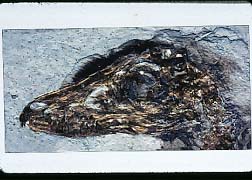
| |
| DUCK?--Detail of Feathered Dinosaur head, on loan from China to Amerian Museum of Natural History. | |
Dinosaur species with primitive feathers were first discovered in 1995, in China's Liaoning Province fossil-beds, site of many astounding fossil finds. During the dromaeosaur's visit to the United States, it will also visit Texas to get a CAT Scan so scientists can better study its three-dimensional structure.
Some skeptical scientists still refuse to accept as fact the theory that birds—as we now know them—evolved from some species of dinosaur. But the fossil now on view at the American Museum—as well as other recent feathered-finds in China—certainly seems to be hard evidence of a close structural/biological relationship between the Avians and these primitive Reptilians.
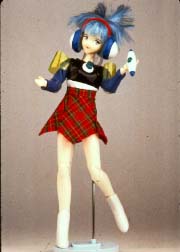
| |
| ARTISTS WORK WITH PARKETT--Mariko Mori's Star Doll. ©Mariko Mori/1998. | |
Great "Books" at MoMA!
PARKETT Collaborations & Editions
[Closing June 5, 2001] Beautifully designed, printed, & bound books are hardly novelties. They have been around since the invention of the printing-press. But strikingly designed magazines—with innovative formats and surprising contents—are largely creations of the 20th century.Even in the 19th century, however, there were fashion and art magazines which featured tipped-in prints, pochoirs, patterns, or engravings. Some of these were also hand-colored. Or semi-mass-produced with stencils.
Godey's Ladies' Book was much admired. Unfortunately, if you find a copy of one of these journals today, the original artworks have gone missing years ago. Later, there was the Gazette de Bon Ton.
With the advent of Fleur Cowles' FLAIR, however, the specially-designed magazine began to come into its own. Individual issues became Instant Collector's Items. In fact, I once had a complete run—not so difficult as the magazine did not have such a charmed long life as expected.
Who walked off with my Flairs?
When Andy Warhol began publishing a new magazine—which would arrive in a variety of formats & with unbound contents—I also subscribed. After all, this brief-lived art-adventure was reminiscent of Marcel Duchamp's Box in a Valise art-kits.
I know what happened to them, however. They all went—with most of my library—to the University of California. Where—as with many of my books—they were probably sold in the Libe foyer for 25¢ apiece. Because of their very special design & contents, they were not easily shelvable.
The much newer magazine, NEST—to which I also subscribe—has avoided the cuteness of Duchamp & Warhol, but its editor does favor odd formats: some without square corners. Others with an + burned right through the issue.
Metropolis—which is distinguished both by its striking & innovative design and by its provocative text & photos—doesn't play games with its format. But it is outsize, so I cannot easily read it on the subway…
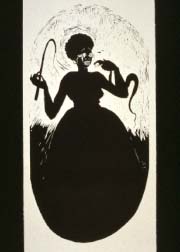
| |
| COLLABORATIONS WITH PARKETT--Kara Walker's Boo-Hoo. ©Kara Walker/2000 | |
Only now do I discover this handsome series of magazines—each issue really worth collecting—when it is much too late to put together a run. Or certainly too costly, as each issue has been devoted to close collaboration with one or more celebrated contemporary artists.
Manhattan's MoMA is the only American museum to own a complete set of PARKETT, as well as a number of individual works of art specifically created for individual issues.
This pristine run of PARKETT was acquired by MoMA in 1998, but only now have some of the issues and original artworks been put on display. In the current show—mounted in collaboration with Parkett Publishers—over 150 of the artworks are on view.
Among the artists featured are Louise Bourgeois, Gilbert & George, Roni & Rebecca Horn, Jeff Koons, Peter Fischli & Eric Fischl, Damien Hirst, Francesco Clemente, Katharina Fritsch, Robert Wilson, Mariko Mori, Bruce Nauman, David Hammons, Glenn Ligon, Georg Baselitz, Rachel Whiteread, Chuck Close, Brice Marden, Ed Ruscha, Laurie Anderson, Sigmar Polke, Richard Prince, Nan Goldin, Ilya Kabakov, Vanessa Beecroft, and, of course, Cindy Sherman, Matthew Barney, Jenny Holzer & Ross Bleckner—along with many other of the Usual Suspects.
Anyone who is a regular at the Whitney or MoMA—not to mention the New Tate, the Hamburger Bahnhof, Centre Pompidou, Vienna's MAK, & SFMoMA—will recognize not only the ubiquity of their names, but also the TradeMarks of their distinctive styles.
In one issue, I was surprised to discover photos of Giulio Romano's murals & frescoes in Mantua's Palazzo Te. They are, of course, very good photos—nothing gimmicky.
Unless you regard a rear-view of the Sun-God Apollo's bare-buttocks—as he drives his chariot aloft through the Heavens—as deliberately titillating, provocative even…
But that is actually in the ceiling-fresco, not only in the photograph itself. It is not one of these trendy new digital-manipulations.
I myself made just such a photo some years ago, when the murals were being restored. Because I try to get the shot that I want in the camera—and not with later cropping—this was not easy. I had to maneuver around the painters' scaffolds & canvases.
Frankly, I think my photos of Apollo, the Mantuan Ducal Horses, and Samson pulling down some Temple columns are quite as good as in that issue of PARKETT. I even photographed the appalling initials some recent visitors had incised in the restored Samson mural!
But, alas, I am not among the charmed folk above, whose works cover the walls of major museums. I have yet to have my once-promised initial exhibition in the City University Graduate Center as a "New York State Artist."
If something doesn't happen soon, all my fifty years of INFOTOGRAPHY photo-images may disappear into the bowels of the New York Public Library, never having been on display…
Of course, I do very much want them there on 42nd & Fifth permanently, so the images can be used. But it would be gratifying—after 50 years of obscurity—to have a real show at last. And not merely use the photos to illustrate my articles & lectures…
It would also be wonderful to be featured in PARKETT, but that obviously only happens to Already Certified Contemporary Artists. And with a long line of shows to their credit. Why would anyone be interested in an Unknown? Or want to collect his Images?
In publication since 1984, there are now 60 issue-volumes of PARKETT. Special editions of artworks, however, have ranged from a very limited 20 copies to as many as 2,000. But most are limited to around 70.
As Parkett now publishes 12,000 copies per issue, many subscribers obviously are not automatically receiving original artworks.
Parkett Publishers have prepared a compact handbook of their various issues, with texts by Deborah Wye & Susan Tallman. It's 4" x 6" & 346 pages, with many color-reproductions. It bears the same title as the MoMA show: Parkett: Collaborations & Editions Since 1984.
Digital Artworks at the Whitney—
BITSTREAMS & DATA DYNAMICS
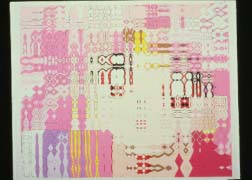
| |
| WHITNEY BITSTREAMS--Carl Fudge's Rhapsody Spray 1. Feldman Fine Arts. | |
Actually, it's much better if you use your own photos & drawings—to avoid copyright infringement issues—if you want to publish or sell your digitized artworks.
Some of the creations on view in Bitstreams & Data Dynamics are in fact quite striking—and also attractively packaged for the commercial art-market.
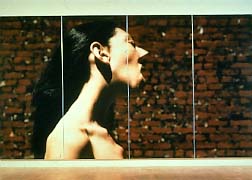
| |
| WHITNEY BITSTREAMS--Inez van Lamsweerde's Me Kissing Vinoodh (Passionately). Eileen & Peter Norton Collection. | |
But this is a rather new area of art-exploration, so there must be, of necessity, some false-starts and magnificently misguided obsessions.
But the potential for creation of entirely new two-dimensional printed-out artworks—whether collaged or completely reconstructed photos, or original prints & drawings—is tremendous. Even endless in its permutations and possibilities…
As shown at the Whitney, it is also possible to create illuminated & animated two-dimensional computer-programed boxed artworks which constantly vibrate and instantly change with shimmering lines, angles, planes, patterns, geometrics, perspective-solids, and dots & squares of brilliant color scooting up, down, & across on seen & unseen grids. John F. Simon, Jr, has two very impressive examples of these Color Panels on display.
It struck me forcefully that one of these wonderfully hyper-active light-boxes could just as easily be programed with the ever-changing geometrics of the After-Dark™ screen-saver I have on my computer-monitor.
I don't want to see Flying Toasters drifting across my wall when I come back from, say, The Producers. But it would be soothing & delightful to see rainbow-spectrumed arcs & cascades of ever-changing geometric forms glowing in a simple black-box, alone on a stark white wall.
Of course, all kinds of visual adventures are possible with digitally manipulated videos and online creations, not least inter-active artworks. There are ample examples at the Whitney. You can even talk to some video-digital artworks! And there are some artworks which exist purely as sound programs.
Of course you could also talk to the Mona Lisa in the Louvre, but she'll only answer you with that same old unchanging smirk. How about having a real conversation with Mona? That is now very possible.
How would you like to talk to Gilbert Stuart's George Washington? Some computer-freak could make this possible for you as well.
Or perhaps you'd prefer to cuddle up to an Odalisque by Ingres?
How about digitally cloning a Last Supper to drive Mayor Rudy bonkers? Something that would make that INDECENT version at the Brooklyn Museum seem stuff for Sunday-School?
With Stock Photos, Art Prints, Photoshop Software, Scanner, Imagination, & PC, you could provide a Last-Supper seating-arrangement that would make Jackie Kennedy's White House State Dinners look like McNuggets at the Golden Arches!
You could, for instance, show Idi Amin eating body-parts—as he was alleged to have done, with a freezer full of really cold cuts. After all, isn't the Last Supper/Eucharist actually about the Miracle of Partaking of the Holy Blood & Flesh?
For an added shocker, you could construct a Sound-Component. Why not use that old bad-taste stand-up-comedy tagline? The one in which Judas whispers to the waiter: "Put it on separate checks!"
One use of digital technology I found particularly fascinating—if a bit ghoulish in its execution—is Robert Lazzarini's distorted sculpted skulls. Computer-programed 3-D perspective distortions of an actual skull enable Lazzarini to construct strange skulls with grinning white teeth—all made of basic garden-fodder bone-meal!

| |
| TELLING TALES AT DAHESH--Swiss sculptor Jean-Jacques Pradler's Standing Sappho. | |
Even the less inspired Romans copied famous Greek sculptures.
The problem with paintings from the classical period—aside from those wall-frescoes preserved by volcanic ash at Pompeii & Herculaneum—is that the mediums on which they were created did not survive the centuries, the Millennia…
So it has been from the survivals of Classical Sculpture & Architecture that artists of the Renaissance and especially the Neo-Classical Period have been able to reconstruct the Glory & Grandeur of Ancient Greece & Rome.
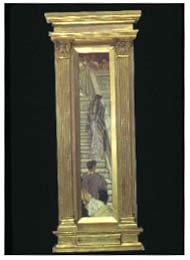
| |
| DAHESH NEO-CLASSICS--Alma-Tadema's elegantly slim The Staircase. | |
Henri Godet's sculpture of Cupid Abducting Psyche may be overshadowed by another less mythical and more rapacious female-removal, Jaroslav Cermák's Abduction of a Herzegovenian Woman. The Serbs are still into this kind of enforced courtship. And, in the Balkans, not only the Serbs…
So do ask a guard if you want to enjoy the view. And see "Joel Shapiro on the Roof."
Actually, you aren't likely to see Shapiro himself. He was there for the Press-Preview, of course, but this apostle of Abstract Modernist sculpture has left some striking examples of his recent work behind him, sedately & stolidly in place on the wooden deckings.
If you admire the welded metal sculptures of David Smith or Mark di Suvero, Shapiro's structures may seem a bit too tame, too derivative. But they are, nonetheless, bold and bright.
A colleague complained to me that a few of the constructions looked too much like the realities that may have inspired them.
At least in naming the figures, Shapiro has been coy enough to cloak his sources by calling all of them UNTITLED!
Centuries from now, Art Historians—if any remain—will be totally confused by the thousands and thousands of pieces of late 20th century art bearing the name Untitled.
Considering the time, effort, & cost-of-materials that have gone into the creation of these artiste-disante artworks, it may seem odd to our Distant Descendants that no one could think of a name for the individual pieces.
Most of these unnamed works—some eminently forgettable, or even unnecessary—are much too large to put inside a NY Times Time-Capsule. So, with any luck, they will bio-degrade over five-hundred years' time.
Shapiro's untitled blue solid-geometry of a stick-figure seemed to annoy my friend especially, but I rather liked this Elemental Man.
And so will many of the Met's Spring, Summer, & Fall visitors. If they can find the elevator.
Overlooking Cleopatra's Needle—
JOEL SHAPIRO on the Met Roof
[Closing Late Fall/Weather Permitting]
The Met Museum is so immense, many visitors do not even know there is a Met Roof from which they can survey Central Park and its framing borders of skyscrapers. Even if they know there is such a vantage-point, they may not be able to find the elevator which will take them there. Camelot Comes Alive at the Met!
JACQUELINE KENNEDY:
[Closing July 29, 2001]
The White House Years

| |
| THE WHITE HOUSE TOUR--Jacqueline Kennedy welcomes TV viewers to her home. | |
In the Met Museum's current display of Mrs. John F. Kennedy's private and public gowns, suits, frocks, dresses, and sports-outfits, the smartness & stylishness is everywhere apparent. But the basic silhouette doesn't vary much. Variation often manifests itself in a range of bright pastel colors. Set off with a single simple brooch…
But this major Kennedy Fashion-Show is not only an occasion for Dresses on Parade. It's also a Virtual Tour of the White House during the Kennedy Years. In fact, the video of the TV Tour, led by Mrs. Kennedy, is running over & over. As are video-tapes of other important events during this semi-imperial Presidency.
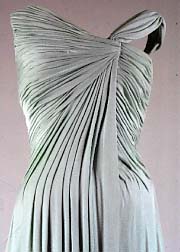
| |
| SOMETHING SIMPLE, OLEG!--Jackie Kennedy's Cassini gown for the Nobel Laureates' Dinner at the White House. | |
In one room, the walls are handsomely decorated with seating-plans for some of Mrs. Kennedy's more ambitious State Dinners. The names of the famous guests are handwritten out from a central point, as spokes in wheels representing their respective tables.
Because the Met Museum's most glittering—and possibly most productive in fund-raising—Benefit Gala is its Costume Institute Spectacular, it is fortunate that this season's show stars the late, but still glamorous, Jackie Kennedy Onassis.
For that reason—and the generous loans from the Kennedy Library & Museum—major second-floor galleries have been set aside for the exhibition.
In previous seasons, because the Costume Institute's tiny, cramped exhibition-spaces are at the foot of a great staircase leading down to a Basement Nowhere, it has always seemed distinctly peculiar to have all those Glittering Celebrities, Society Gorgons, & Merchant Princes crowded before those narrow glass-cases.
This Spring, however, Society had its proper scope, and in surroundings appropriate to its Wealth & Power. And Self-Esteem!
The General Public won't enjoy the same experience. But at least it will be able to experience the White House as it once was—when it was a demi-Camelot.
At the Press-Preview, Caroline Kennedy Schlossberg—Honorary Chair of the Costume Benefit Gala—spoke about the genesis of this handsome exhibition.
Met Director Philippe de Montebello also noted that she—like her much-admired mother—has been a stalwart Met Museum supporter, even working in the Photographic Department!
The buzz was that all the living Presidential Ladies would be on hand that evening for the Gala. Naturally, ink- or laser-jet-stained wretches from the press were not invited to check this out.
Fortunately, important gossip-columnists—who now provide the only real news reported in New York—were on hand to note that First Lady Laura Bush departed before the arrival of former First Lady and now Second Senator from New York, Hillary Rodham Clinton.
Although the late President's Widow was almost exclusively known—during her later, Post-DC, Manhattan incarnation—as "Jackie-O," nothing in the current show distracts from her Proper Place in History.
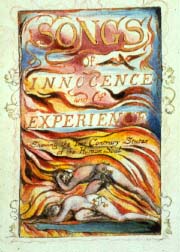
| |
| SONGS OF INNOCENCE & EXPERIENCE--Title-page designed, etched, & colored by poet/painter William Blake. | |
A glance at the prices he had set on these now almost priceless works is even more astounding. They weren't exactly give-aways, but, even by the valuations of the time, they were certainly affordable.
If one loved poetry, admired colorful & unusual imagery, and appreciated the inspiration, thought, skill, & care which had gone into the making of these hand-made books, one should certainly want to buy the entire series of titles. Or at least a beautiful copy of Songs of Innocence and of Experience?
But Blake was a poor man—though a richly endowed artist, poet, & visionary—and he remained poor all his life. He had not the facility to make himself and his work widely known. Nor were some of his writings of the sort that would be widely understood or even appreciated.
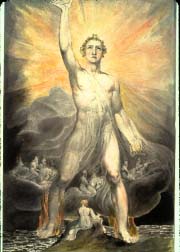
| |
| ANGEL OF REVOLUTION--Blake's visionary image in the era of the American & French Revolutions. | |
Fortunately, Blake did find admiring patrons who admired and partly understood his genius, if not all of his imaginary Cosmology, an inspired reaction to conventional religious beliefs.
Now, at the Metropolitan Museum, Blake's most significant and important works are on view. Among the more than 175 selections, there are a number of copies of plates from his illustrated books, which were carefully bound by his wife & partner, Catherine.
Even people who know nothing of Blake as a painter, prophet, or print-maker, know of him at least as that English poet who wrote the mysterious lines: "Tyger, Tyger, burning bright/In the forests of the Night…"
This is the first time the Met has been able to offer such a wide-ranging retrospective of Blake's life & works, borrowing widely from major museums and collections. But, before the 1978 Blake exhibition at the Tate in London, Blake was still best known for his poems—and generally regarded as a rather special, even peculiar, minor artist.
Among the major works now at the Met are Ancient of Days, Angel of the Revelation, Nebuchadnezzar, and Newton.
Blake's Newton is a seated, forward-leaning nude figure, calipers in hand, intently studying the ground-plane before him. It was apparently inspired by a similar Michelangelo figure in the Sistine Chapel.
But, in its turn, it has also inspired Edward Paolozzi to create a gleaming bronze Newtonian statue, which now sits in the forecourt of the new British Library!
William Blake made his own book-plates, not only because he was too poor to afford a commercial printer for his books. But also because he wanted complete textual & artistic control—some of his ideas were plainly seditious in the context of the times.
In the current exhibition, some of Blake's surviving copper-plates are on display. And there is an interesting explanation of the unique process of relief-etching, by which he was able to fix both texts & images on his pages.
In addition to the plates, paintings, and etchings, there are also some impressive engravings: his Job and Edward and Eleanor. As well as his illuminated books, such as America, a Prophecy, The Marriage of Heaven and Hell, and The Daughters of Albion
Blake's strange cosmological visions are also explored and illustrated in this provocative show. For a poor, virtually self-educated man, who left London only once—and that, a disastrous experience—Blake's ability to conceive an alternative vision to the prevailing Christian Cosmology, with a Pantheon of strangely-named Gods & Heroes, seems even now quite remarkable.
True, both he and his younger brother—who died young—had apprenticed as engravers, so he was not without some artistic & technical training. But he did not develop his unique book-plates merely from his apprentice experience. His dead brother Robert inspired him in visions.
No wonder some who knew of Blake—and who might have left their descendants a fortune in his books & prints—thought he was both crazy and a Crank.
Unfortunately, this attitude became widely held after his death—not diminished by the perusal of some of his more veiled & visionary texts. This engendered the neglect in which Blake and his works have languished until recently.

|
| THE ANNUNCIATION--Illuminated 15th Century Florentine Miniature. |
2] Euclid's Elements of Geometry, a Venetian first-edition, dated 25 May 1482—£80,000.
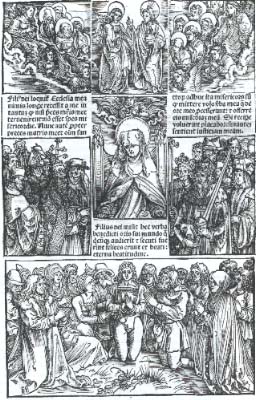
|
| REVELATI0NS OF ST. BRIDGET--Nuremburg woodcut from 1500 AD. |
[For the Record: Maggs Bros Ltd—FAX: +44 20 7499 2007.]
At a number of booths, dealers generously gave me exemplary copies of recent catalogues. Many of these are Collectors' Items in themselves. They are also very useful references, as manuscripts, books, illuminations, maps, engravings, woodcuts, and prints are described in detail, with current sale-prices.
You may discover, to your horror, what that old copy of T. S. Eliot's poems you threw away was really worth!
The Sims Reed catalogue of Antiquarian Books is certainly one I will put on my Reference Shelf. It is not only filled with wonderful books I'd love to own, but it's also been most handsomely designed & printed. Most of the large illustrations are in color!
Here are some Sims Reed treasures:
1] Malory's King Arthur, a three-volume set of the de luxe edition of 300 copies, illustrated by Aubrey Beardsley—£60,000. Or another less impressive set—£30,000.
2] Complete set of Edward Gordon Craig's theatre-magazine, The Mask—£5,400.
3] Kelmscott Press Works of Geoffrey Chaucer—£85,000.
4] Scamozzi's Palladio, with plates showing such architectures as the Teatro Olimpico in Vicenza—£14,000.
5] Album of 90 Piranesi etchings of Carceri, Grotteschi, Prospettive, Antichita, & Architettura—£125,000. [My own Piranesi, the Cloaca Maxima of Rome, I bought years ago in a Munich junk-shop for DM 10.]
[For the Record: Sims Reed Ltd—FAX: +44 20 7493 8468.]
But the Brits aren't the only booksellers who produce stunning catalogues. Ursus Rare Books in Manhattan has a splendid example in Catalogue 217. All the internal illustrations are in black & white, but it has an impressive Oskar Kokoshka color-cover.
1] Suite of 12 original signed photographs by Berenice Abbott—$9,500.
2] First editions of Jane Austen's Northanger Abbey & Persuasion, published posthumously in four volumes—$12,000.
3] True first-edition of Samuel Beckett's En attendant Godot, No. 27 of the edition of 35 copies—$40,000.
[For the Record: Ursus Rare Books Ltd—FAX: 212-737-9306.]
But these handsome references are only the tip of the catalogue-berg I acquired at the Armory show.
From the attractive catalogue of the Boston firm of Buddenbrooks, I discover that I can obtain a copy of a children's classic by a very distant Scots Bannerman cousin, namely Helen Bannerman's Little Black Sambo. For only $295, or $395, depending on the edition. [Whatever became of my own copy, surely older than these?]
Buddenbrooks also has a first-edition of Mark Twain's Adventures of Tom Sawyer, for $4,500. Now that the work has become a Broadway musical, the price may go even higher? A first-edition of Joel Chandler Harris' Uncle Remus—no longer Politically Correct—is priced at $1,950.
A first-edition of Alice in Wonderland, from Buddenbrooks, is priced at $9,850. But an inscribed presentation copy costs $12,500.
[For the Record: Buddenbrooks—FAX: 617-267-1118.]
If I get nostalgic for my origins, I could pay $8,500 for John Lawson's Map of the Gold, Silver & Quicksilver Regions of Upper California, from High Ridge Books of Rye, New York. This is listed in Catalogue 42: 18th & 19th Century American Maps & Broadsides.
Or, similarly, I could recall early San Francisco in a copy of Carleton Watkins photographic Panorama—shown recently both at the Met Museum and at the SF Museum of Modern Art. This costs $25,000, from the William Reese Company of New Haven.
So I think I'll just hold onto my May 1906 Panorama, a color lithograph of the April 1906 San Francisco Earthquake & Fire. This cost me only £10 pounds years ago in London at the Friday Caledonia Market.
But Reese has some outstanding photos, prints, and paintings of various American scenes in the 19th century. Among them: William Henry Jackson's l873 Photographs of Yellowstone National Park, etc is priced at $150,000. Less costly, at $125,000, but no less striking are the Union Pacific Railroad continental views in Alfred J. Russell's The Great West Illustrated.
[For the Record: William Reese Company—FAX: 203-865-7653.]
Not to overlook—though time & cyberspace are running out—the handsome catalogues of London's Bernard Quaritch: Art & Architecture—No. 1282, Archaeology—No. 1286, Design & Decoration—No. 1287. [FAX: +44-20-7437-0967.]
Or the Librairie Thierry Corcelle Catalogue 31, with its wonderful collection of colorful children's games, cutout dolls, illustrations, & books.
Or the Ken Lopez/Bookseller catalogue of Native American Literature. But there's also a tiny Lopez catalogue: No. 114—Modern Literature. How about $4,500 for an inscribed copy of Willa Cather's Death Comes for the Archbishop?
Or $25,000 for F. Scott Fitzgerald's This Side of Paradise, inscribed in the week of publication? A first-edition of Harper Lee's To Kill a Mockingbird for $12,500? Reviewer Malcolm Cowley's proof-copy of Hemingway's Old Man and the Sea, at $22,500?
As for Salinger's Catcher in the Rye, Ken Lopez has offered a single Salinger letter about the novel for $22,500!
Did I make a mistake in not offering all my Joe Orton letters at auction? Not really. I think it's right that they are now in the Berg Manuscript Collection of the New York Public Library. And the NYPL should soon have my INFOTOGRAPHY photo-archive as well.
This great Spring Bibliophilic Extravaganza was yet another of the fine shows produced every season at the Park Avenue Armory by Sanford L. Smith & Associates. For information about future events, FAX 212-477-6490.
[Loney]
Copyright © Glenn Loney 2001. No re-publication or broadcast use without proper credit of authorship. Suggested credit line: "Glenn Loney, Curator's Choice." Reproduction rights please contact: jslaff@nymuseums.com.